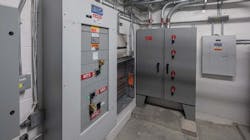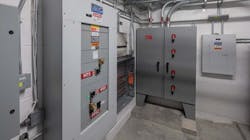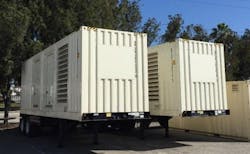With a push from a National Electrical Code revision, a federal ruling, new federal infrastructure legislation, and a closely watched demonstration project due to come online, the door to a new frontier of microgrids in the health care market may be slowly cracking open in 2024.
Seen in some quarters as a potentially good fit for hospitals and other mission critical health care facilities, microgrids utilizing renewable energy could provide access to cleaner, cheaper and more reliable power, each a growing concern in the sector.
Projects are far from proliferating, but conditions could be ripe for their emergence. Last year, the Centers for Medicare and Medicaid Services (CMS) cleared the way for subject hospitals to utilize microgrids as a first line of defense against power outages, removing the requirement that diesel generators be in place as a backstop. That decision followed a 2021 update to the National Fire Protection Agency’s Health Care Facilities Code (NFPA 99) that permits facilities to rely solely on qualifying power systems that utilize renewable energy for emergency power, doing away with the long-standing requirement for generators as the sole source of backup power.
Complementing those rulings, there’s now the prospect of significant government financial assistance for health care microgrid projects. The Inflation Reduction Act includes microgrids in its long list of energy conservation projects eligible for credits, and hospitals meeting the requirements are potential beneficiaries.
Meanwhile, the second leg of a demonstration project the California Energy Commission is funding that will answer more questions about the viability of health care microgrids is taking shape. Health care microgrids are drawing particular attention in the Golden State, where power interruptions tied to wildfire prevention have become more common. And one hospital operator working with CEC has been leading the way.
At its Ontario Medical Center in Southern California, Kaiser Permanente is installing a microgrid that has a 2.2MW solar array, a 9.5MWh zinc hybrid battery and a sophisticated controller. It follows an earlier microgrid installation at Kaiser’s Richmond Medical Center, a smaller project that pairs 1MW of battery storage with a 250kW, on-site solar panel installation on the hospital’s parking garage roof (see Photo 1).
A CEC description of the Ontario project highlights the need for more proof that microgrids can meet the exacting demands of a health care environment that would justify investment in a renewables-based system, notably “day-to-day energy, greenhouse gas reductions and energy storage that can provide long duration support to a facility, particularly during an outage.” It will be directly compared to the Richmond project on multiple factors, and on critical backup power capability be “tested for the ability to serve nearly 100% of hospital loads for 12 hours or more.”
As a health care industry leader in prioritizing cleaner, conservation focused energy solutions, Kaiser sees the microgrid projects as vital to expanding the industry search for new ways to power energy-dependent facilities at a time of growing risk and uncertainty.
“Increasingly due to the climate crisis, we're having more and more weather-related disasters, which can also affect grid reliability,” says Seth Baruch, Kaiser’s national director of energy and utilities. “Therefore, hospitals and other public services must put into place better, more resilient options for maintaining operations.”
Microgrids, he says, could be the answer to mitigating the effects of disasters that impact grid power availability, doing so in a way that better protects the environment than reliance on diesel generators.
California hospitals, like most others across the country, rely heavily on diesel generators for backup power. California’s have been targeted for scrutiny by a non-profit that works to safeguard hospital emergency power systems, Powered for Patients.
The group’s latest effort is helping Los Angeles County Emergency Medical Services develop a Los Angeles County Healthcare Facility Emergency Power Resilience Playbook. Published last fall, it lays out detailed protocols for helping county hospitals limit risk to patient and occupant safety in the event of grid power outages. The risk is high in large part because many county hospitals operate with generators that might not be reliable, because of age and/or an insufficient number of reliable units. To account for that, the agency maintains a fleet of mobile generators that can be ferried to locations needing emergency power (see Photo 2).
A survey it conducted found 15 county hospitals operating only one emergency generator. In nine of them, the generators were more than 30 years old, the upper reaches of useful life. As of last fall, only two of those single-generator hospitals had signed on to participate in an EMS program that utilizes real-time generator monitoring technology to flag potential reliability problems. Extrapolating the county findings, Powered for Patients estimated in 2022 that about 800 of the nation’s 4,750 acute-care hospitals had only one generator, and that more than half of them were more than 30 years old.
That, along with growing concerns about the cost and climate-friendliness of the power they consume in massive quantities, could set the stage for continued progress on health care microgrids. Many critical questions about their viability — especially the reliability of renewables-based emergency power — remain unanswered, though, meaning that progress, if it comes, is likely to be slow. More insight, though, is surely coming as research cranks up.
About the Author
Tom Zind
Freelance Writer
Zind is a freelance writer based in Lee’s Summit, Mo. He can be reached at [email protected].


